How to get rid of spider mites on cucumbers in a greenhouse: the best means and ways to fight
Many gardeners and gardeners, as well as indoor florists, are familiar with this dangerous and omnipresent pest firsthand. Indeed, the spider mite, alongside with melon aphids, it is one of the most dangerous pests on cucumbers (especially in the greenhouse), which does real damage to plants and greatly reduces your yield.
Next, we will try to figure out how to effectively deal with spider mites on cucumbers, how (with what drugs) to process plantings in order to prevent its spread even at the early stages of development.
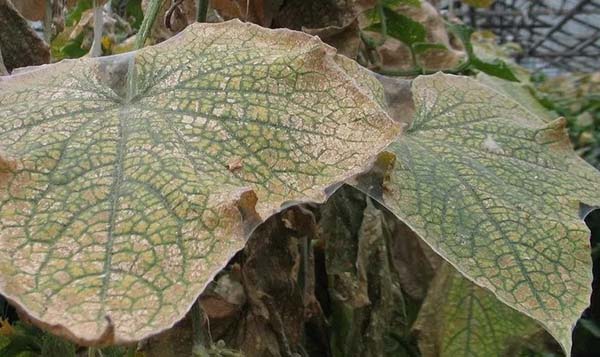
Content
Spider mite: who is it, signs and conditions of appearance on cucumbers
A spider mite is not an insect, but an arachnid animal or, as it would be more correct to say, a species of a spider mite.
Therefore, to combat ticks, not ordinary insecticides (insect control agents) are used, namely acaricides - preparations for the fight against ticks.
A spider mite is a leaf-sucking pest that sucks the juices from the leaves of a plant, which is why they first turn yellow (turn brown), and then curl up, dry out and fall off. Therefore, it is very important to detect the pest at the early stages of its appearance and take the necessary measures.
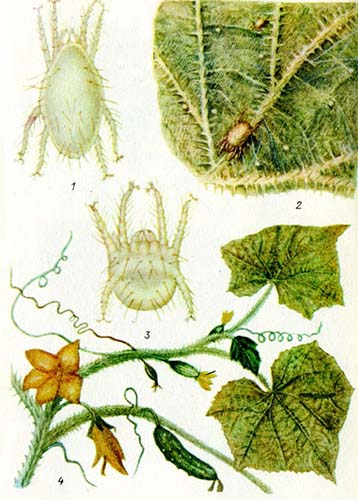
It is quite difficult to notice the tick itself on your plants (unless only through a magnifying glass or microscope), because its length is less than 1 mm (only about 0.3-0.6 mm).
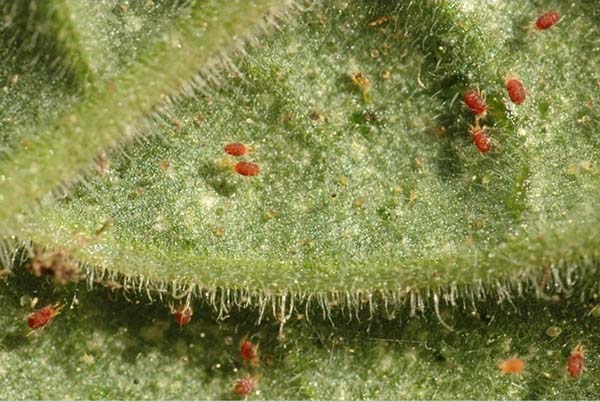
However, it is possible to determine that a spider mite has wound up on your cucumber plantings by external signs, namely: on affected leaves with them inner (bottom) side will be noticeable small cobwebs, a on the front side - pale yellow spots-dots (which later merge together).
Important! Do not confuse with peronosporosis (downy mildew) and thrips.
Ideal conditions for the emergence of spider mitesa is dry and hot weather (+30 degrees)especially during periods of summer drought. Therefore, it is most often found in the southern regions, as well as in indoor growing flowers, vegetables (the same cucumbers on the balcony) and berries (the same strawberries on the windowsill).
By the way! Ticks reproduce most actively on plants that literally feed on excess nitrogen fertilizers. And just, on the contrary, less susceptible pest attack plants that receive excess phosphates.
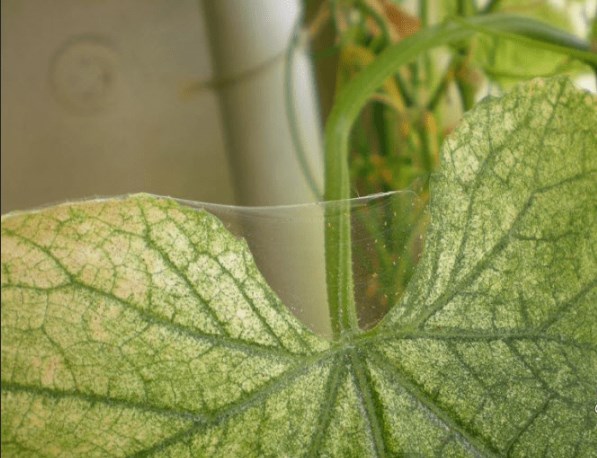
Respectively, greenhouse conditions Is the same ideal environment for spider mites.
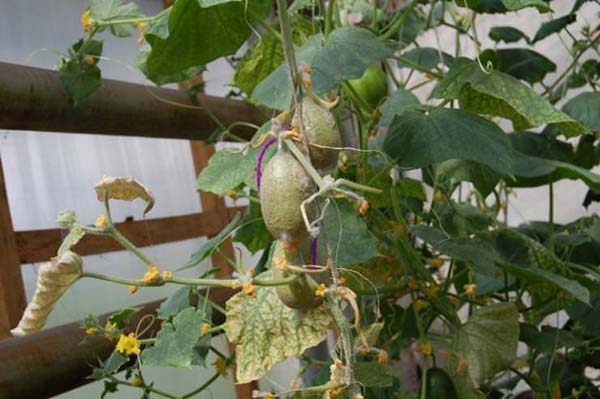
By the way! Also, eggplants from garden crops are especially susceptible to the attack of spider mites, currants and gooseberries from berry crops, and petunias, roses and hydrangeas from floral crops.
But strawberries in the open field infect a strawberry mite.
Video: spider mite on cucumbers - signs of infection
Preventive measures against spider mites on cucumbers
If the main conditions (so to speak, reasons) favorable for the appearance of a spider mite on cucumbers is dry and hot air, then it is quite obvious that main preventive measure to prevent the appearance of this pest is timely and regular watering = maintaining optimal humidity.
Let's repeat! The tick loves a dry microclimate, therefore, with prolonged dry weather, in the evenings, cucumbers should be sprayed with warm water, and at the first signs of its appearance - treated with acaricides.
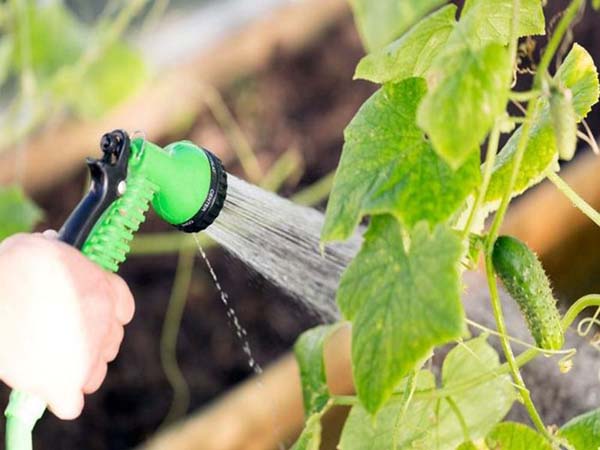
If the leaves of cucumbers are in excellent condition - they are dense, well-watered with water, they have an excellent turgor, then the spider mite simply cannot pierce the surface of the leaf and break through.
In other words, proper care for cucumbersespecially their timely watering, and high-quality feeding (plants overfed with nitrogen are most susceptible to diseases and pest attacks, so more potassium and calcium are needed) and regular ventilation of the greenhouse - the main limiting factors for the mass development of spider mites.
By the way! The site already has detailed articles about how to properly water cucumbers in the open field and in a greenhouse, and how to feed in summer during flowering and fruiting.
Also, among the agrotechnical measures for the prevention and protection of plants from the appearance of a spider mite include:
- thorough destruction of weeds (primarily quinoa, nettle, shepherd's purse);
Advice! About, how to deal with weeds in the garden and vegetable garden, detailed here.
- annual spring processing of the greenhouse (including disinfection and cultivation of the soil, or removal of the topsoil).
And how properly prepare the greenhouse and the ground in it for the new season in spring, read here.
How to properly spray cucumbers from spider mites
A few tips for treating cucumbers for spider mites:
- Perfect timing for processing it is early morning or late evening, or cloudy and calm weather.
However, always pay attention to the instructions for a specific preparation, since some agents, especially biological ones, work only at high daytime temperatures.
- Before processing it is highly desirable collect all the cucumbers.
- Spraying should be done first. on the lower (inner) side of the sheet (i.e. process not as usual, from top to bottom, but from bottom to top).
Why? It's simple if you read the previous paragraph - after all, it is from the bottom of the sheet that the spider mite begins its attack.
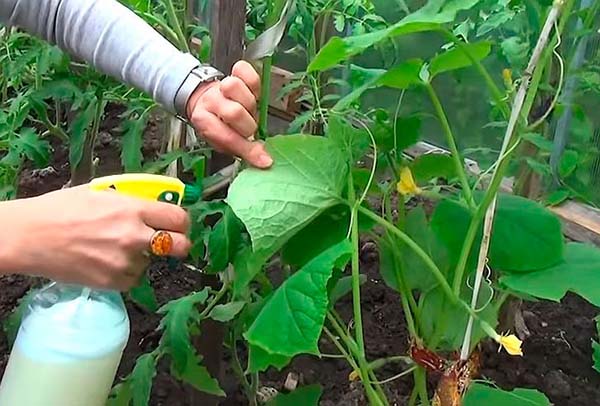
- A tick has several developmental stages, which means that you will need different preparations for processing at each phase.
- You must at a certain frequency (depending on the weather: if from + 12-20 degrees - 1 time in 2 weeks, if higher, then 1 time in 5-7 days) repeat treatmentssince many drugs simply do not work on eggs.
The fact is that if you do not observe the frequency of treatments, then a new army of pests will simply hatch from the laid eggs, after 3-5 days they will become sexually mature and begin to lay eggs themselves.
- Always pay attention to waiting times, i.e. the number of days after which you can eat processed foods.
How to deal with spider mites on cucumbers
If you did not follow the cultivation technique for cucumbers (especially in the greenhouse) and the spider mite literally attacked your plants, then you will have to take serious measures to combat this dangerous and harmful pest.
In the initial stage, when the foci of spider mite spread are small, you can manually remove the affected leaves. However, this does not guarantee that you will completely get rid of the spider mite. Most likely, you just haven't noticed it on the rest of the leaves.
There are many ways to deal with spider mites on cucumbers. Some of them are more effective, some less. There are quite cardinal ones, others, on the contrary, are very gentle.
Ideally, you should periodically change the drugs so as not to addictiveness to the tick and it could develop resistance. Different preparations = products with different active ingredients.
Chemicals
The mildest, more prophylactic (protective) than therapeutic agents include colloidal sulfur, however, it is effective only in hot weather (from 20 to 30 degrees, not higher or lower).
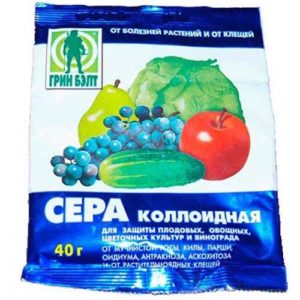
Or a drug Tiovit Jet.
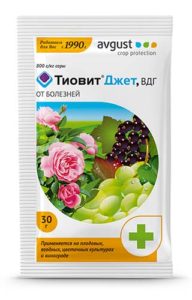
Organophosphorus compounds (FOS)
These are drugs strong and total action, which destroy both egg-laying and larvae of sexually mature individuals, i.e. able to rid your garden of ticks at all stages of their development.
The active ingredients are indicated in brackets, and the most popular and effective insectoacaricides are highlighted in bold.
- Fufanon-Nova (Malathion (Karbofos);
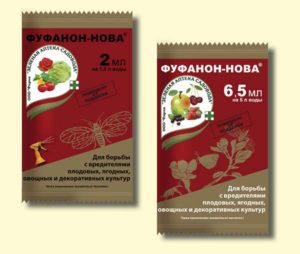
- Karbofos (Malathion (Karbofos);
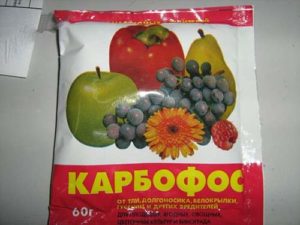
- Actellic (Pirimiphos-methyl (Actellic);
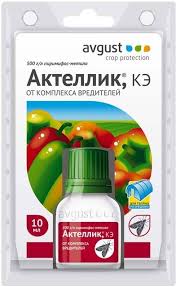
- Anti-mite (Malathion (Karbofos);
- Kinfos (Beta-Cypermethrin + Dimethoate);
- Ditox (Dimethoate).
These are the most toxic agents and have the longest waiting period. Therefore, they should be used only in the most compelled situations.
Pyrethroids
Compared to previous organophosphorus compounds (OPs), they are much safer and non-phytotoxic.
- Karate Zeon (Lambda Cyhalothrin);

- Clipper (Bifentrin (Talstar);
Other effective chemicals
- Masai (Tebufenpirad);

Acts on all mobile stages of tick development, has a strong ovicidal effect (summer egg-laying).
At the same time, it can be used during the flowering period (safe for bees), and also does not act on predatory mites.
- Vertimek (Abamectin).
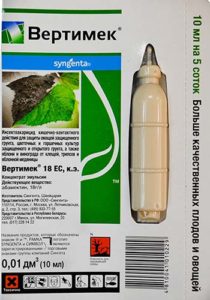
Biological agents
Biologics mainly effective only against adult (sexually mature) ticks, for eggs they do not work, so processing necessary to repeat at least twice, and preferably 3-4 times!
But this the most environmentally friendly and safest products against spider mites (especially if you use them during the fruiting period), and they are quite effective.
The biological preparations that will help you in the fight against spider mites on cucumber plantings include the following (in parentheses - the active substance, and the most popular and effective ones are highlighted in bold):
- Akarin (Avertin N);
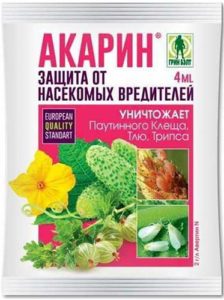
- Aktofit (Aversectin C);
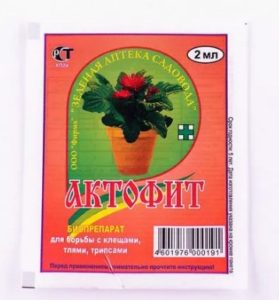
- Kleschevite (Aversectin C);
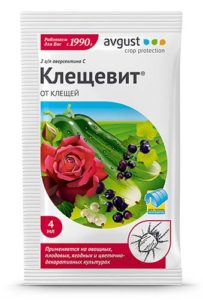
- Fitoverm (Aversectin C);
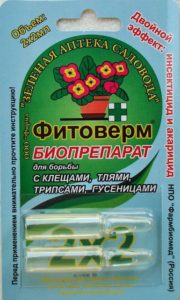
Fitoverm, as you understand, is the same Aktofit or Kleschevit, tk. they have one active ingredient!
- Bitoxibacillin (Bacillus thuringiensis var.thuringiensis).
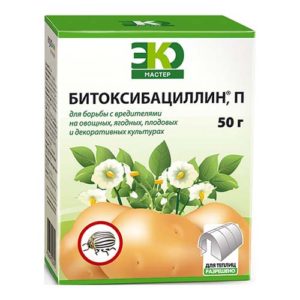
Advice! It is very effective to use a tank mixture of Aktofit (or Fitoverm) and Bitoxibacillin.
Video: the use of bitoxibacillin (BTB) against spider mites on cucumbers in a greenhouse
By the way! Also, the following biological products are often added to the tank mixture from other diseases and pests: Planriz, Trichodermin, Gaupsin and Mikosan B.
Carnivorous ticks
If you are growing cucumbers in a greenhouse (greenhouse), to kill the spider mite, you can launch predatory mites, namely Ambliseius and Phytoseiulus.
For more details on how to use predatory mites, see the next video from the Garden World channel.
Video: predatory mites against spider mites on cucumbers
Folk remedies
You can also destroy the tick on cucumbers with the help of folk remedies. In particular, solutions work well, thanks to which you can apply a thin film to the tick, as a result of which it cannot breathe and eventually suffocates. Namely, these can be the following adhesives (film-forming agents - protein or fat):
- oil (rapeseed or sunflower);
- soap (from 40 to 400 grams of laundry or green soap per 10 liters of water);
- milk whey (to which it is also desirable to add soap, as well as a little ammonia);
- infusion of garlic.
And some gardeners recommend pouring directly onto the bushes after spraying wood ash, so to speak, to powder.
You can also find advice that calendula able to protect your plantings from ticks (or rather, scare off with its smell). However, to be honest, this is a very ineffective measure of protection.

Thus, now you know how to deal with spider mites on cucumbers. The main thing is to start doing it in time so that the vile pests do not have time to reduce your yield!
Video: spider mite cucumbers - how to detect and defeat it

